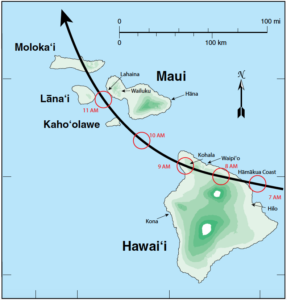Hawaiian-Language Newspapers Reveal new Data on 1871 Hurricane

Reconstructed track of the 1871 hurricane across islands of Hawai‘i and Maui; Businger et al., 2018.
A recent study by two local scientists reveals that Hawaiian-language newspapers added significant new information to an account of a major hurricane that struck the islands of Hawai‘i and Maui on Aug. 9, 1871.
Though the storm was documented in ship logs and English newspaper accounts, the scientists—a Hawaiian language expert and an educator at the University of Hawai‘i at Mānoa— and their team extracted enough information from the Hawaiian-language accounts to document the intensity and track of the storm for the first time.
Their research uncovered a detailed timeline of the 1871 storm hitting Waipi‘o, Kohala and Maui and the destruction that followed. One account said: “There were 28 houses blown clean away and many more partially destroyed. There is hardly a tree or bush of any kind standing in the valley.” Another mentions “the wooden houses of the residents here in Hāna were knocked down.”
Puakea Nogelmeier, a professor of Hawaiian language at UH Mānoa, director of the UH Institute of Hawaiian Language Research and Translation (IHLRT) who led the research team and co-authored the study, has worked for years to convert Hawaiian-language newspapers to a word-searchable digital format that is publicly available.
Between 1834 and 1948, more than one hundred independent newspapers were printed in Hawaiian. This archive contains the largest native-language cache in the Western Hemisphere—more than a million typescript pages of text—and are now being recognized as a significant source of data for day-to-day events of the past.
Steven Businger and Thomas Schroeder, professors in the UH Mānoa School of Ocean and Earth Science and Technology (SOEST), partnered with Nogelmeier and his graduate students to extend translation research in the Hawaiian language papers, looking specifically for geophysical stories, including the hurricane of 1871. They produced a digital database of more than 4,000 articles related to meteorology and geology.
“Puakea’s vision has helped conserve Hawaiian language of the past and is opening a window on the historical record that has been long overlooked in Hawai‘i,” said Businger, lead author of the study and professor of Atmospheric Sciences in SOEST.
Businger and JIMAR are continuing their research of Hawaiian-language articles relating to floods, droughts, high surf, storms, landslides, earthquakes, tsunamis and volcanic eruptions.
“The goal of the ongoing work is to extend our understanding of geoscience back into historical, post-contact and pre-contact times to project and prepare for future events,” said Businger. “It is important to note that there would be much greater destruction if a storm of similar intensity and track were to occur today.”
The data gathered from translated articles will also be incorporated into local classroom curriculums.
“These translations are important for STEM education because the articles show that universal public education during the Hawaiian Kingdom led to highly literate citizens, always observing, commenting, communicating and sharing information that others were free to comment on,” said Pauline Chinn, professor in the UH Mānoa College of Education (COE) and co-author of the study. “These are the fundamental processes of science inquiry—sharing of data and interpretations in a public forum for commentary and critique.”













